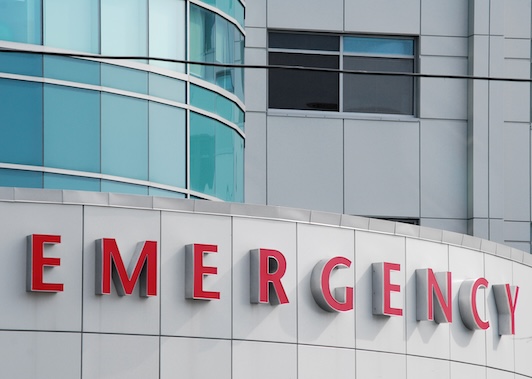A cyclist is struck by a car and in critical condition.
In the Emergency Department (ED), a call goes out – “Code Shock” – bringing together a range of health care professionals to aid in decision-making to provide care to the critically ill patient, who is in a life-threatening condition due to severe blood loss.
This was the simulated scenario of the new emergency protocol – which goes live on Monday, June 17 at both Toronto Western (TWH) and Toronto General (TGH) hospitals.
It will standardize and streamline the care of patients who present to the EDs requiring rapid resuscitation and specific interventions related to trauma and undifferentiated shock.
Code Shock brings together an immediate in-person response team made up of professionals from emergency, anesthesia, critical care, respiratory care therapy awnd general surgery, as well as additional support as required from JDMI, Blood Bank and bed flow.
It is designed to support the clinical team in identifying patients requiring timely trauma and shock intervention and ensuring the necessary resources are available to provide optimal care through coordination and clear decision-making, improving the timeliness of emergency interventions, quality of care and patient safety.
“The EDs at UHN treat some of the sickest patients in the province, and sometimes this requires the rapid deployment and formation of a multidisciplinary team,” says Dr. Thomas Forbes, Surgeon-in-Chief, Sprott Department of Surgery at UHN.
“This is what Code Shock is about, experts working in teams for the benefit of our patients.”
The development of the protocol was a recommendation from a serious safety event which occurred in 2023. This led to the development of a Code Shock working group, who built the protocol.
In early June, the EDs at both TWH and TGH practiced a mock Code Shock where members of the multidisciplinary immediate response team practiced providing care to a patient requiring hypotensive resuscitation – a resuscitation strategy that uses fluids and blood products during the early stages of treatment for hemorrhagic shock, a life-threatening condition caused by severe blood loss.
“Simulation is important because we want to make sure what’s on paper is impactful and safe for patients and providers in real life,” says Dr. Alia Dharamsi, Director of Simulation at UHN.
“A mock simulation allows us to identify latent safety threats or gaps within the protocol, as well as improve the team’s communication, which in turn supports understanding and role clarity.”
One advantage of the mock trials was that they were physically performed in the EDs – rather than a simulation room – allowing for staff who work outside the department an opportunity to orient themselves within the walls of the usual care space, using the standard equipment when Code Shock is called in the future.
“Most staff who will be attending a Code Shock won’t have ever met or worked with each other before and will be expected to perform in a high-stress, high-acuity patient resuscitation scenario,” says Dr. Alyssa Louis, a critical care physician at TWH.
“The simulation helps us to analyze team dynamics and identify how people might work together in the future, allowing us to identify opportunities for improvement.”
The protocol does not replace rapid transfer for trauma patients to a Level 1 Trauma Centre – such as St. Michael’s Hospital – which is strongly equipped to provide care for patients suffering from major traumatic injuries such as falls, motor vehicle collisions or gunshot wounds.
The Code Shock team will ensure there is support for the multisystem trauma patient while awaiting transfer. For patients who do not meet the clinical criteria for transfer, such as a patient presenting with undifferentiated shock and the cause is unclear, the Code Shock team will be the first to respond.
By Catherine Danko


